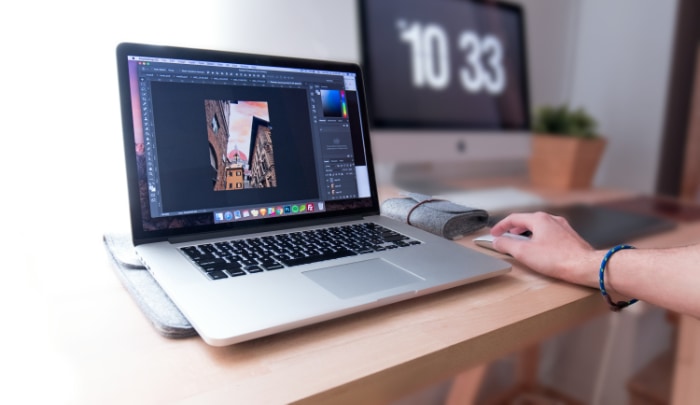Mouse vs. Touchpad: Crafting Your Ideal Workspace

Selecting the right tool for computer interaction is more than a mere preference; it's about optimizing productivity, comfort, and efficiency. Picture yourself tackling a complex graphic design project or swiftly navigating through spreadsheets.
The device under your fingertips – be it a mouse or a touchpad – can significantly influence your performance and overall experience. While the mouse has been a steadfast ally in desktop computing for decades, the touchpad, integrated seamlessly into laptops, offers a sleek, space-saving alternative.
Ergonomics and Comfort
The way we interact with our devices significantly impacts our comfort and health. Ergonomics, the science of designing products to fit the user's body and reduce discomfort, is crucial when choosing between a mouse and a touchpad.
Mouse: Designed for the Hand
Mice are crafted to fit the contours of the hand, allowing for a natural grip and movement. High-end models even offer adjustable shapes and sizes to cater to individual preferences.
This tailored design helps minimize strain on the hand and wrist, especially during extended periods of use. However, the benefits of a mouse's ergonomic design can be offset if the device is not positioned or used correctly, potentially leading to discomfort or repetitive strain injuries.
Touchpad: Space-Saving and Integrated
Touchpads, integrated directly into laptops, offer a sleek and space-efficient way to navigate your computer. They eliminate the need for additional desk space and can be used in tight spots, like while traveling or in cramped meeting spaces.
The absence of moving parts means your hand and fingers can glide smoothly across the pad. Yet, this convenience may come with a trade-off in terms of precision and the potential for awkward hand positioning, which can lead to discomfort over time if not addressed.
Understanding Your Body's Needs
Every user is unique, with different hand sizes, shapes, and personal comfort preferences. Some may find the tactile feedback of a mouse click satisfying and less tiring than the constant touch gestures required by a touchpad.
Others might prefer the streamlined, minimal approach of a touchpad, especially when space is at a premium. It's important to listen to your body's signals. If you notice discomfort, numbness, or strain, it may be time to reassess your choice or seek ergonomic accessories, like wrist rests or stands, to enhance your setup.
The Balance of Movement and Rest
Both devices require a balance of movement and rest. With a mouse, it's crucial to ensure that the arm and wrist move as a unit to avoid overextension.
For touchpad users, varying finger movements and regularly changing hand positions can help prevent fatigue. No matter your choice, taking short breaks, stretching, and practicing good posture are essential habits to maintain comfort and prevent strain.
Precision and Control
In tasks that demand accuracy, like graphic design or gaming, the level of precision and control offered by your input device is paramount. Both the mouse and the touchpad have their strengths and weaknesses in this domain, influencing user experience and performance in various activities.
Mouse: Aiming for Accuracy
The mouse, with its physical movement and dedicated surface, typically offers superior precision. Adjustable sensitivity settings, such as DPI (dots per inch), allow users to fine-tune their experience, making the mouse a favorite in scenarios that require meticulous control, like photo editing or fast-paced gaming.
The physical feedback of a click and the ability to swiftly move the cursor across multiple screens further enhance the mouse's reputation for accuracy and control.
Touchpad: Gestures and Swipes
Touchpads support multi-finger gestures, offering a different kind of control and fluidity in navigation. Pinch-to-zoom, two-finger scrolling, and three-finger swiping for multiple desktops are features that can make the touchpad feel intuitive and seamless in everyday tasks.
However, when it comes to pixel-perfect precision, touchpads may fall short, often requiring users to make multiple attempts to position the cursor exactly where needed.
Learning Curve and Adaptability
Users often experience a learning curve when adapting to a new input device. For someone accustomed to a mouse, the touchpad's sensitivity and gesture-based control might initially feel less precise.
Conversely, touchpad enthusiasts might find the mouse's physical movement cumbersome. Adaptability plays a crucial role, and with time, users can achieve a high level of precision with either device.
Environmental Factors
The environment can also influence the performance of these devices. A mouse requires a flat surface and some space to move, which can be a limitation in cramped or unconventional work settings.
On the other hand, the touchpad's compactness makes it versatile, although its performance can be affected by factors like the user's finger moisture or the touchpad's cleanliness.
Portability and Space Requirements

The digital age demands flexibility and mobility, making the portability and space requirements of computer peripherals more relevant than ever. Whether you’re a student hopping from class to class, a professional moving between meetings, or a creative soul seeking inspiration in new locales, how you carry and where you use your input device matters.
Mouse: Mobility with a Catch
Mice are portable, with many wireless options available that are easy to pack and carry. However, their reliance on a flat surface for operation can be a limiting factor.
In environments like cafes, libraries, or compact office spaces, finding enough room to maneuver a mouse can be challenging. Additionally, while wireless mice eliminate the tangle of cords, they introduce the need to manage batteries or charging, adding an extra layer to consider in your mobility setup.
Touchpad: The Epitome of Space Efficiency
Touchpads are the epitome of space efficiency. Seamlessly integrated into laptops, they require no additional space beyond the device itself.
This integration ensures that the touchpad is always at your fingertips, ready for use, whether you're cramped in an airplane seat or lounging on your sofa. The absence of external devices or wires also streamlines your work setup, making the touchpad an ideal choice for those who value a clean and minimalistic workspace.
Considering Your Workspace
Your typical workspace plays a significant role in determining the most suitable input device. For users who frequently change locations or work in space-constrained environments, the compactness of a touchpad can be a significant advantage.
Conversely, for those who have a dedicated workspace and value precision over portability, the space requirement for a mouse is a worthwhile trade-off.
Adapting to Different Scenarios
Many users find value in having both a mouse and a touchpad at their disposal, choosing between them based on the specific scenario. For instance, one might prefer a mouse when working at a spacious desk but switch to the touchpad when mobile.
Understanding the portability and space requirements of each device allows users to adapt their setup to match their current situation, ensuring productivity and comfort are always at the forefront.
Customization and Functionality
In a world where personalization is highly valued, the ability to customize and adapt your devices to your specific needs is more important than ever. Both mice and touchpads offer various levels of customization and functionality, allowing users to tailor their interaction with their computer to their preferences and work habits.
Mouse: Tailor-Made Experience
Mice provide a broad spectrum of customization options. Users can adjust sensitivity settings like DPI to control cursor speed and precision, a feature particularly cherished by gamers and graphic designers.
Programmable buttons allow for the creation of shortcuts to streamline workflow, enhancing productivity. Moreover, ergonomic options, including adjustable weights and grips, cater to individual comfort preferences, making the mouse a highly customizable tool for computer interaction.
Touchpad: Gesture Control and Efficiency
Touchpads offer a different kind of customization, primarily through gesture controls. Users can execute a variety of commands through simple gestures, such as swiping with multiple fingers to switch desktops or pinching to zoom.
Although these gestures are generally standardized, some systems allow users to customize and add new gestures, providing a personalized touch to the touchpad experience. This gesture-based control emphasizes efficiency and ease of use, fitting seamlessly into the flow of intuitive navigation.
Software Customization
Both devices are supported by software that allows for further customization. For mice, this might include adjusting scroll speed, pointer precision, or setting up custom profiles for different applications.
For touchpads, software options might allow users to adjust sensitivity, toggle specific gestures, or modify scrolling directions. This level of software support ensures that both mice and touchpads can be finely tuned to meet the unique needs of each user.
The Role of Functionality in Device Choice
While customization is crucial, the core functionality of the device often plays a more significant role in the choice between a mouse and a touchpad. The mouse is generally favored for tasks that require precision and rapid input, while the touchpad is prized for its streamlined design and gesture-based navigation.
Users must consider both the customizable features and the inherent functionality of each device to make an informed decision that aligns with their personal and professional needs.
Durability and Maintenance

The lifespan of your input devices is a key factor in determining their overall value and effectiveness. Durability and ease of maintenance are essential considerations, especially in today's fast-paced, technology-driven world.
Both mice and touchpads have their own set of durability concerns and maintenance needs, influencing their long-term viability and performance.
Mouse: Built to Last with Care
Mice are generally durable, designed to withstand thousands of clicks and movements over their lifetime. However, like all physical devices, they are subject to wear and tear.
The buttons might start to stick or respond less over time, and the scroll wheel may lose its smoothness. Regular cleaning is essential to prevent dirt and debris from affecting performance.
For wireless mice, battery life is an additional factor, requiring users to monitor and replace batteries or charge the device regularly.
Touchpad: Minimalist but Sensitive
Touchpads are minimalist in design, lacking movable parts, which inherently makes them less prone to mechanical failure. However, they are not immune to issues.
The surface can become less responsive over time, especially if not kept clean. Exposure to liquids or extreme pressure can also impair functionality.
On the plus side, touchpads don't require much maintenance beyond regular cleaning with a soft, slightly damp cloth to keep the surface sensitive and responsive.
Handling and Repairs
Both mice and touchpads are relatively robust, but how they are handled can significantly impact their longevity. Dropping a mouse or spilling liquid on a touchpad can lead to immediate and sometimes irreparable damage.
When issues arise, mice might be easier to repair or replace due to their external nature and modular design. Touchpads, being integrated into laptops, can be more challenging and expensive to repair, often requiring professional service.
Best Practices for Longevity
To maximize the lifespan of these devices, proper care and usage are paramount. This includes storing the mouse in a protective case during transport, avoiding exposure to liquids and extreme temperatures, and keeping the touchpad and mouse clean and free from debris.
Adhering to these practices ensures that your chosen input device remains a reliable and effective tool for computer interaction.
Conclusion
Choosing between a mouse and a touchpad isn't just a matter of preference; it's about aligning your choice with your specific needs, work habits, and personal comfort. Through exploring the facets of ergonomics, precision, portability, customization, and durability, this discussion sheds light on the unique advantages and considerations of each device.
Mice offer unmatched precision and customizable options, making them ideal for tasks that demand accuracy and personalization. Touchpads, celebrated for their integrated design and gesture-based controls, are perfect for users valuing space efficiency and seamless navigation.
Recognizing the importance of ergonomics ensures that your choice enhances comfort and reduces strain during prolonged use. Considering the portability and space requirements of your work environment helps in selecting a device that complements your mobility.
Weighing the customization options allows you to tailor the device to your workflow, boosting productivity. Acknowledging the durability and maintenance needs of each option ensures your choice remains a reliable tool over time.
Your ideal input device should not only meet today's needs but also adapt to tomorrow's challenges. By carefully considering these factors, you're well-equipped to make an informed decision, ensuring that your choice between a mouse and a touchpad enhances your digital interactions, productivity, and overall computing experience.


